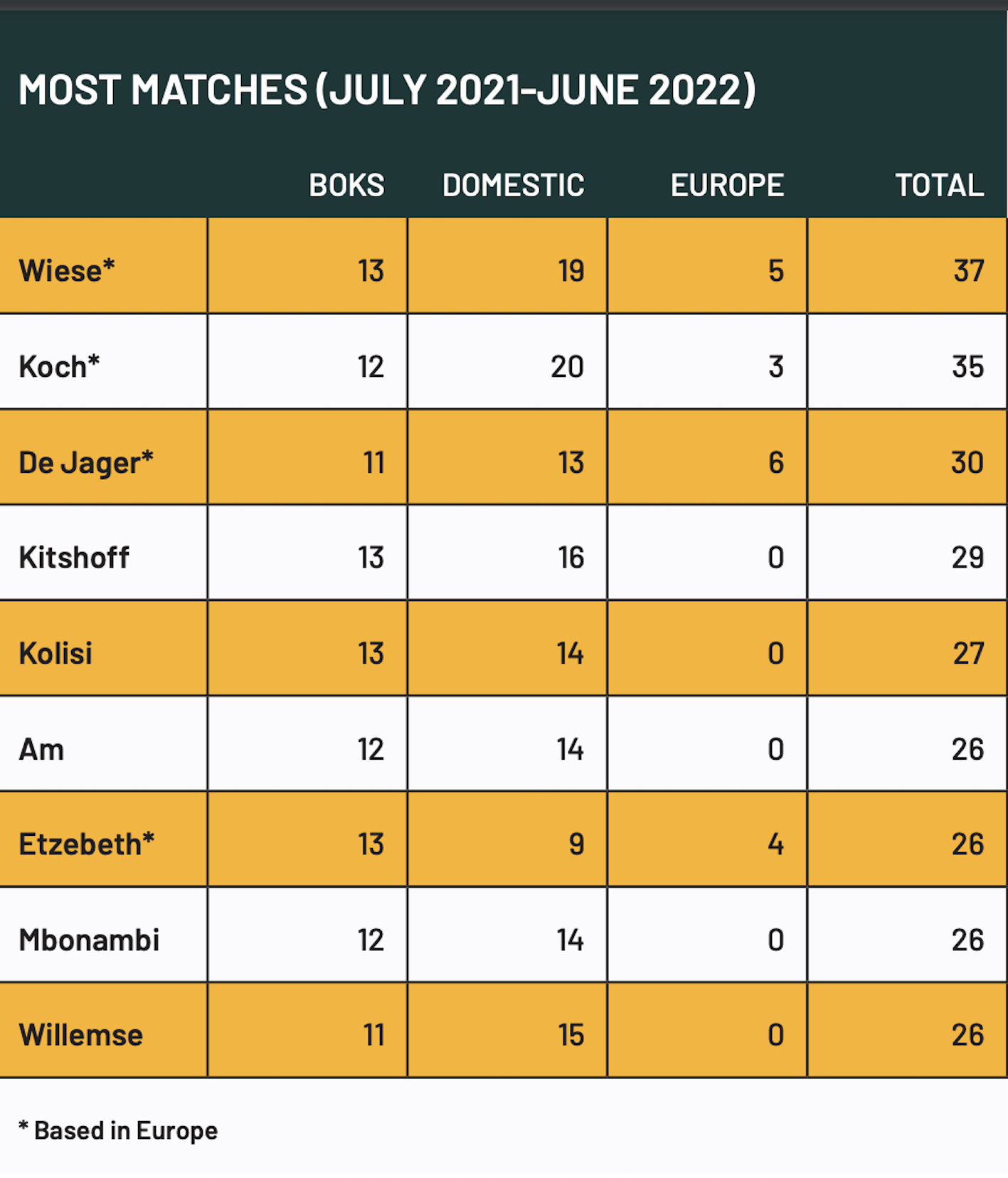RUGBY
Relentless rugby schedule poses danger to SA’s top Springboks

South Africa’s top players are competing all year round. SA Rugby and MyPlayers – the SA rugby players’ organisation – have already moved to address the concerns about player welfare within the local community. But little can be done at present about a situation in which South Africa’s top players – particularly those based overseas – compete all year round.
Over a 12-month period, SA-based players will be limited to a maximum of 32 games or an equivalent, to mitigate physical fatigue, mental burnout and associated injuries and illnesses.
South African rugby aligned itself with the northern-hemisphere season (September to June) when the top franchises joined the United Rugby Championship (URC) in 2021.
At the same time, SA Rugby honoured its commitment to Sanzaar and the Rugby Championship – a tournament staged during the European off-season (August and September).
South African rugby finds itself in a unique and dangerous situation. Top Springboks are subjected to extensive workloads over a 12-month period. Thereafter, they have little opportunity to rest or condition their bodies before the next cycle begins.
It’s a problem that may be solved by the Boks leaving the Rugby Championship to join the Six Nations, or by the Rugby Championship staging its matches in the same international window as the northern-hemisphere showpiece.
The current broadcast deal expires in 2025, though, and for now, the club and international schedule – as well as the player-welfare pitfalls – will remain unchanged.
How the game cap works
Until then, rugby bosses will attempt to “control the controllables”.
SA Rugby and MyPlayers have determined that the “South African season” begins in July and ends the following June. The Bok coaches enjoy access to the top players for the entire international season – the inbound tour in July, the Rugby Championship and the outbound tour to Europe in November.
Local players who are in the mix for the end-of-year tour are withdrawn from their franchises and will miss the first part of the URC as a result.
From late November to June, players turn their attention to the domestic leagues and to European tournaments such as the Champions Cup and the Challenge Cup.
After consulting with a host of experts, SA Rugby and MyPlayers have set a game cap at 32 matches for the period between July 2022 and June 2023.
A 20-minute shift constitutes a game. Anything less is viewed as “an involvement”, and the cap on all involvements per season will soon be set at 35.
“We consulted with the player conditioning experts in the European rugby market who have gained extensive experience over the years in these competition formats,” MyPlayers CEO Eugene Henning told DM168. “We want to ensure that the player load is managed.”
With the season “starting” with the inbound tour in July, it appears that the national coach is in the best position regarding access to the elite players. Jacques Nienaber has the freedom to select Steven Kitshoff, for example, in all 13 Tests between July and November.
When the Test schedule concludes, Kitshoff’s franchise coach John Dobson has to manage the prop over the remaining URC and Champions Cup matches. If Kitshoff plays all 13 matches across the Test season, he can play 19 more games for his franchise before he hits the game cap of 32.
That’s before local resting protocols are taken into account, though. According to Henning, there will be dedicated rest periods for South Africa-based Boks that the franchise coaches will have to adhere to.
Players who ‘breached the cap’ in 2021/22
Applying the game cap to the most recent season provides one with a better idea about how it works.
Earlier this month, the concussion campaign group Progressive Rugby sent World Rugby a list of recommendations that could improve player welfare – including a reduction in the number of competitive games (25) to be played by individuals in a season.
A closer look at the 2021/22 campaign confirms that a clutch of local players “breached” that theoretical cap of 25, namely Kitshoff (29), Siya Kolisi (27), Lukhanyo Am, Bongi Mbonambi and Damian Willemse (all 26).

Now consider the Boks who are overseas-based. The respective clubs in Europe and Japan have the final say on how those players are managed, and how many games they play over the course of a season.
Take the management of Jasper Wiese, for example. Leicester Tigers managed the Bok No 8 with their own goals in mind for the 2021/22 season. Wiese didn’t suffer any major setbacks, and was rested at times during the Premiership and Champions Cup campaigns.
By the time the Premiership final concluded, Wiese had played 37 games between July 2021 and June 2022. Shortly after winning the final against Saracens, Wiese rejoined the Boks ahead of the first Test against Wales. He barely had a moment to savour the climax of one season before he was thrust into the next.
Bok and Saracens prop Vincent Koch played 35 games during this period. Sale Sharks lock Lood de Jager racked up 30 appearances.
Eben Etzebeth, who spent a large part of the European season recovering from serious injuries, still managed to finish with a total of 26 matches.
Japanese season a respite for top Boks
Perhaps the current group of Boks will benefit from a comparatively lighter workload in Japan. World Cup winners such as Malcolm Marx, Pieter-Steph du Toit, Franco Mostert, Kwagga Smith, Elton Jantjies, Willie le Roux and Jesse Kriel have been plying their trade in Japan for some time.
From next season, the Japan-based contingent will swell to 10, with De Jager, Faf de Klerk and Damian de Allende linking up with clubs in the Far East.
The decision to play in Japan will mitigate the situation for some players. For those based elsewhere, there is a real threat of fatigue, burnout and injury.
A move towards a more aligned season – where there are specific blocks for rest and conditioning – cannot come soon enough. DM168
This story first appeared in our weekly Daily Maverick 168 newspaper, which is available countrywide for R25.


















Comments - Please login in order to comment.